|
 Marasmiellus bonii Marasmiellus bonii
BiostatusPresent in region - Indigenous. Endemic
Images (click to enlarge)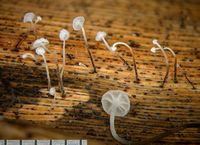
Owner: J.A. Cooper | 
Owner: B.P. Segedin | 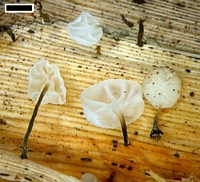
Caption: scale=1mm
Owner: J.A. Cooper | 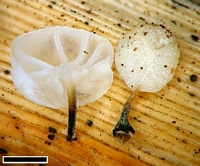
Caption: scale=1mm
Owner: J.A. Cooper | 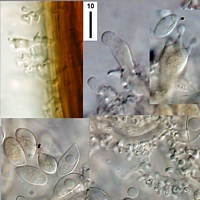
Caption: upper left caulocystidia. Middle top: surface cap cells. Upper right basidium. Lower left spores. Lower right ramealis cap hyphae.
Owner: J.A. Cooper | 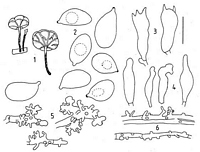
Caption: Figs. 1-6. Marasmiellus bonnii: 1. basidiomes; 2. spores; 3. basidia; 4, cheilocystidia;
5. pileipellis elements; 6. stipitipellis elements. Magnifications: basidiome, bar = 10 mm;
basidia, cystidia, pileipellis and stipitipellis elements, bar = 20 µm | 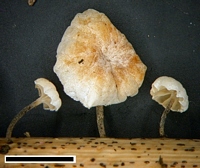
Caption: scale=5mm
Owner: J.A. Cooper | 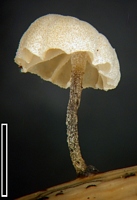
Caption: scale=2mm
Owner: J.A. Cooper | 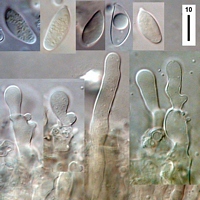
Caption: spores and cheilocystidia
Owner: J.A. Cooper | 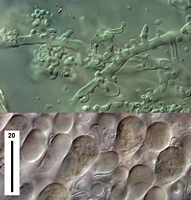
Caption: upper, cap hyphae, lower sub-pellis cells.
Owner: J.A. Cooper | 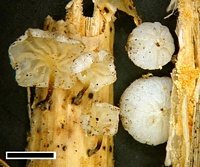
Caption: scale=2mm
Owner: J.A. Cooper | 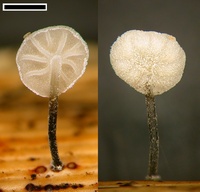
Caption: scale=1mm
Owner: J.A. Cooper | 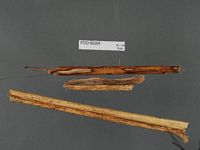
Caption: Dried type specimen
Owner: Herb PDD | 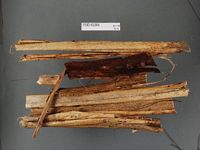
Caption: Dried type specimen
Owner: Herb PDD |
Article: Segedin, B.P. (1995). A new species of Marasmiellus from New Zealand. Documents Mycologiques 25(98-100): 437-440.
Description: Pileus 4-10 mm diam., gelatinous texture, pure white, downy, dry, radially grooved
following the outline of the lamellae, margin slightly incurved, drying ochraceous to
sepia, depending on age. Lamellae white, thick and fold-like, well-spaced, 1-2 series, 5-6
reaching the stipe in small basidiomes, 8-10 in larger ones, sparsely furcate to
intervenose at a lower level. Stipe 8-15 x 2 mm, more or less central, white at apex shading
through yellow brown and sepia to black at the base, dry, even in diameter, cystidiate,
insititious, tough, stipes often remaining attached to the substratum when the rest of the
basidiome has disappeared. Taste and smell unknown. Spore print unknown.
Spores 10-13 x 6-9 (11.9 x 7) µm, Q=1.7, ellipsoid, lacrymoid, sometimes humped on abaxial
side in lateral view, hyaline, smooth, thin-walled, inamyloid, not dextrinoid, acyanophilic,
with a distinct apiculus with a terminal, dark scar. Basidia 30-35 x 11-13 µm broadly clavate,
clamped at the base, 2-, 3-,.or 4-spored, sterigmata short and fat, -3 µm long. Pleurocystidia
absent. Cheilocystidia 30-40 x 6-11 µm, in the form of cystidioles, cylindrical to lageniform,
sometimes nodulose at the apex, thin-walled, infrequent. Trama of sub-gelatinous, more or
less parallel, narrow hyphae 3-4 µm diam. Subhymenium of filamentous, slightly coralloid
hyphae. Context of narrow (2 µm.diam.) gelatinised, interwoven hyphae. Pileipellis of repent
hyphae with well developed rameales to asterostromelloid structure, with short
diverticulations 1 µm diam. Stipitipellis of narrow (-3 µm), brown, repent hyphae with short,
hyaline, thin-walled, simple or shortly diverticulate projections. Trama of lamellae and stipe
not dextrinoid.
Habitat: Habitat : On old dead leaves of New Zealand flax (Phormium tenax), growing in damp
swampy areas.
Notes: M. bonii bears a strong resemblance to M. trabutii var.trabutii but differs in the rather
smaller size of the basidiome, the shallow, distant, thick, fold-like lamellae, mainly in 1
series, smaller spores, more strongly developed rameales structure in the pileipellis, and
shorter protuberances on the stipitipellis.
|